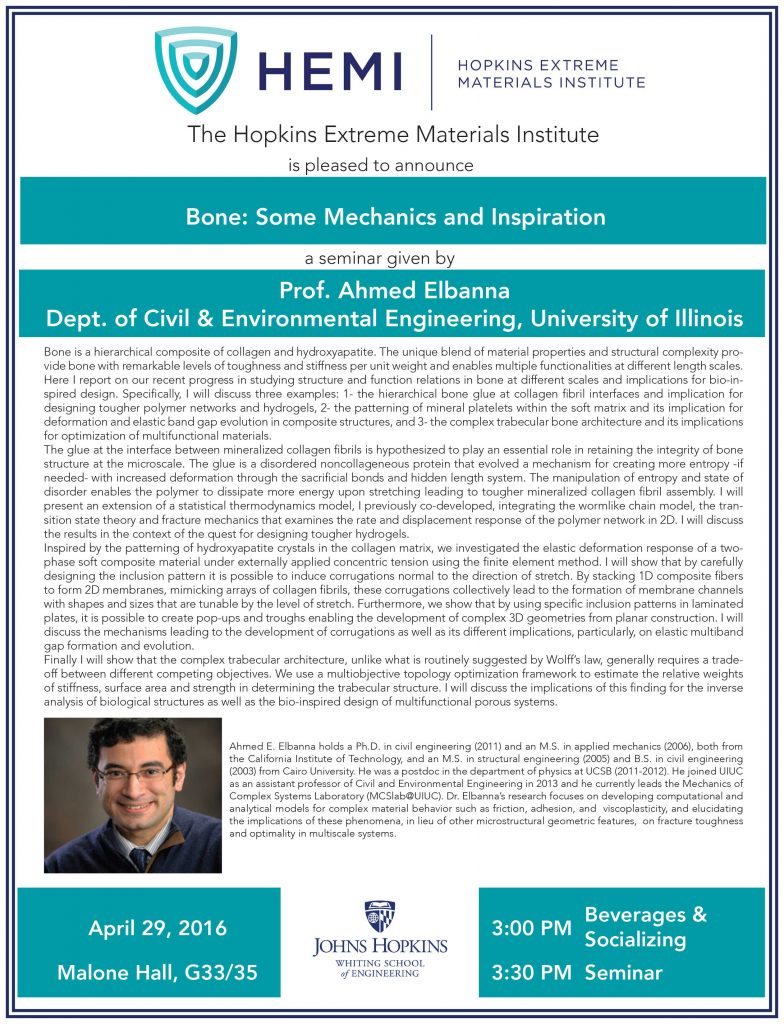April 29, 2016 @ 3:30 am - 4:30 pm
Event Navigation
Bone: Some Mechanics and Inspiration
Bone is a hierarchical composite of collagen and hydroxyapatite. The unique blend of material properties and structural complexity provide bone with remarkable levels of toughness and stiffness per unit weight and enables multiple functionalities at different length scales.
Here I report on our recent progress in studying structure and function relations in bone at different scales and implications for bio-inspired design. Specifically, I will discuss three examples: 1- the hierarchical bone glue at collagen fibril interfaces and implication for designing tougher polymer networks and hydrogels, 2- the patterning of mineral platelets within the soft matrix and its implication for deformation and elastic band gap evolution in composite structures, and 3- the complex trabecular bone architecture and its implications for optimization of multifunctional materials
The glue at the interface between mineralized collagen fibrils is hypothesized to play an essential role in retaining the integrity of bone structure at the microscale. The glue is a disordered noncollageneous protein that evolved a mechanism for creating more entropy -if needed- with increased deformation through the sacrificial bonds and hidden length system. The manipulation of entropy and state of disorder enables the polymer to dissipate more energy upon stretching leading to tougher mineralized collagen fibril assembly. I will present an extension of a statistical thermodynamics model, I previously co-developed, integrating the wormlike chain model, the transition state theory and fracture mechanics that examines the rate and displacement response of the polymer network in 2D. I will discuss the results in the context of the quest for designing tougher hydrogels.
Inspired by the patterning of hydroxyapatite crystals in the collagen matrix, we investigated the elastic deformation response of a two-phase soft composite material under externally applied concentric tension using the finite element method. I will show that by carefully designing the inclusion pattern it is possible to induce corrugations normal to the direction of stretch. By stacking 1D composite fibers to form 2D membranes, mimicking arrays of collagen fibrils, these corrugations collectively lead to the formation of membrane channels with shapes and sizes that are tunable by the level of stretch. Furthermore, we show that by using specific inclusion patterns in laminated plates, it is possible to create pop-ups and troughs enabling the development of complex 3D geometries from planar construction. I will discuss the mechanisms leading to the development of corrugations as well as its different implications, particularly, on elastic multiband gap formation and evolution.
Finally I will show that the complex trabecular architecture, unlike what is routinely suggested by Wolff’s law, generally requires a trade-off between different competing objectives. We use a multiobjective topology optimization framework to estimate the relative weights of stiffness, surface area and strength in determining the trabecular structure. I will discuss the implications of this finding for the inverse analysis of biological structures as well as the bio-inspired design of multifunctional porous systems.
Seminar will be held in Malone G33/35.





